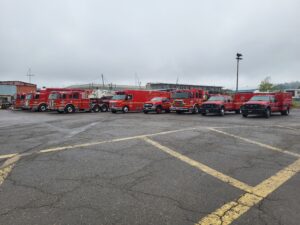Radiation Training for the Seattle Metro Region
Radiation Training the Seattle Metro Region
Radiation Emergency Safety Tactics (REST) LLC, in conjunction with CBRN HQ, conducted a comprehensive Radiological/Nuclear Training and Exercise for the Seattle Fire Department and surrounding agencies. The training combined classroom instruction with realistic outdoor field exercises, ensuring participants gained both theoretical knowledge and hands-on operational skills. After several days of training and drills, the events concluded with a Capstone Exercise based on the DHS First 100 Minutes After an RDD Response Guide.
Classroom Instruction
The indoor portion, supported by a tailored PowerPoint presentation, focused on:
- Ionizing Radiation Fundamentals – Types of ionizing radiation and the detection capabilities of PRDs.
- Source Identification – Differences between Naturally Occurring Radioactive Material (NORM), industrial sources, and nuclear materials.
- Safety Principles – The ALARA concept (Time, Distance, Shielding) and the Inverse Square Law.
- Isotopes of Concern – Profiles of common industrial, medical, and prohibited radioactive isotopes such as Cesium-137, Cobalt-60, Iridium-192, Americium-241, Plutonium-239, and Uranium-235, along with their potential threat forms (RDD, RED, nuclear weapons).
- Threat Awareness – Review of recent national incidents involving theft, accidental release, or attempted malicious use of radioactive materials.
Scenario-Based Discussions
Participants worked through realistic initial arrival scenarios, including:
- Transportation/package incidents involving radioactive materials.
- Explosion scenes with potential Radiological Dispersal Device (RDD) involvement.
- “Sick building” events with multiple casualties exhibiting acute radiation symptoms.
- These exercises emphasized rapid hazard recognition, PPE selection, and the use of guiding reference materials.
Hands-On Field Training
Following the classroom review, crews rotated through three progressive outdoor training formats:
- Static Exercises – Practicing PRD functionality checks, meter settings, and basic detection on fixed live or simulated sources.
- Dynamic Exercises – Active search drills involving small- and large-area sweeps, alarm resolution, and source pinpointing using the Inverse Square Law.
- PlumeSim Exercise – A simulated plume contamination scenario allowing responders to track, map, and manage a radiation release pattern in real time.
Key Outcomes
- Enhanced familiarity with PRD operation under both routine and emergency conditions.
- Improved confidence in identifying and differentiating radiation threats.
- Stronger coordination between classroom theory, field application, and real-world response expectations.
Direct alignment of training content with the Seattle Fire Department’s operational needs and SOPs.





